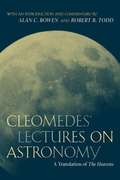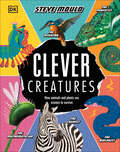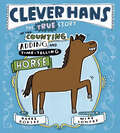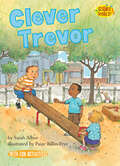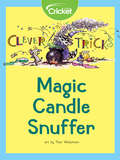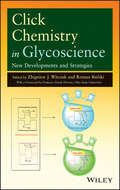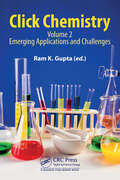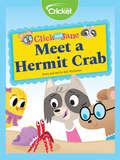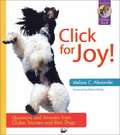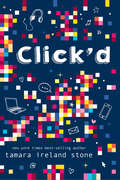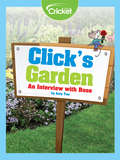- Table View
- List View
Clearing the Air in Los Angeles: The Fight Against Smog (Narrative)
by Carl R. OliverSolving the mystery of California's most persistent smog.Once known as the Smog Capital of the World, Los Angeles has changed "air you can see " into "air you can breathe ." While the fight to eliminate pollution in the city continues, modern smog is not the thick, oppressive, silver-blue haze that drove people to move out of Los Angeles altogether during the mid-twentieth century. Professor Arie Haagen-Smit became a key leader in the fight against smog after making a crucial discovery--what caused it. Join author Carl R. Oliver as he delves into the sixty-year battle to clear the air in Los Angeles.
Clearing the Air: Asthma and Indoor Air Exposures
by Institute of MedicineSince about 1980, asthma prevalence and asthma-related hospitalizations and deaths have increased substantially, especially among children. Of particular concern is the high mortality rate among African Americans with asthma. Recent studies have suggested that indoor exposures--to dust mites, cockroaches, mold, pet dander, tobacco smoke, and other biological and chemical pollutants--may influence the disease course of asthma. To ensure an appropriate response, public health and education officials have sought a science-based assessment of asthma and its relationship to indoor air exposures. Clearing the Air meets this need. This book examines how indoor pollutants contribute to asthma-- its causation, prevalence, triggering, and severity. The committee discusses asthma among the general population and in sensitive subpopulations including children, low-income individuals, and urban residents. Based on the most current findings, the book also evaluates the scientific basis for mitigating the effects of indoor air pollutants implicated in asthma. The committee identifies priorities for public health policy, public education outreach, preventive intervention, and further research.
Clearing the Fog: From Surviving to Thriving with Long Covid—A Practical Guide
by James C. Jackson&“An essential guide&” (Mark Hyman, author of Young Forever) to navigating life with the cognitive and mental health impairments that often accompany Long Covid. Early in the Covid-19 pandemic, the shocking mortality figures obscured the fact that death is not the only adverse outcome of the virus. Today, as many as 30 percent of Covid-19 survivors still experience symptoms long after their acute illness has passed, with cognitive and mental health problems especially prominent. For long haulers, this struggle with Long Covid has irrevocably changed their lives. Many have lost their ability to work, attend school, and look after their children. They often feel misunderstood and dismissed by others. Their once-full lives are now filled only with doctors' appointments that seem more and more futile. In Clearing the Fog, neuropsychologist Dr. James C. Jackson offers people suffering from Long Covid and their families a roadmap to help them manage their &“new normal.&” Focusing on cognitive impairment and mental health issues, he shows readers: The ways in which they can manifest and disrupt Suggestions for how and when to seek professional evaluations Science-based treatment options and strategies, Information on navigating health care systems and disability insurance Validation and hope as patients wrestle with their new diagnosis In addition, Dr. Jackson shares his own experience with chronic illness, relating to long haulers with vulnerability and compassion. Through moving stories as well as hands-on guidance, Clearing the Fog will help long haulers understand their current situation while offering multiple ways to address it, make sense of it, and move through it with the goal of thriving instead of merely surviving.
Cleomedes' Lectures on Astronomy: A Translation of the Heavens
by Robert B. Todd Alan C. Bowen CleomedesCleomedes' treatise was a milestone in the history of astronomy, and is an invaluable resource for students of ancient Stoicism as well.
Cleveland School Gardens (Images of America)
by Joel MaderThe Cleveland Public School's tract garden program was one of the most successful and innovative programs of the school system. The organization and beauty of the gardens attracted horticulture educators from all over the United States, South America, and as far away as Japan. From its humble beginnings in 1904 as a project to beautify vacant lots in Cleveland, it grew into an educational tool that taught thousands of children the respect for nature and its bounty. At the tract gardens' height, the amount of land under cultivation in the middle of the Cleveland urban landscape approached 100 acres. By 1970, there were 27 horticultural centers servicing all Cleveland schools. Centers were located next to schools, in housing estates, at fairgrounds, at a home for the aged, and on museum property. A few of the centers are now neighborhood gardens. The photographs in Cleveland School Gardens show that the Cleveland Public Schools knew the importance of being "green" 100 years before it was politically fashionable.
Clever Camouflage
by John WoodwardDefines two types of animal camouflage (cryptic colouration and mimicry) and describes how various animals use camouflage to hide from predators or disguise themselves from prey.
Clever Creatures: How Animals and Plants Use Science to Survive
by Steve MouldA look at animals and plants from the point of view of their amazing scientific adaptations.Join bestselling author Steve Mould to uncover nature's greatest scientists, engineers, and mathematicians from plants that can count to architect insects. If you thought all scientists wear white coats and work in labs, think again!Meet amazing engineers, such as the spiders who build immense webs from different kinds of silk; funky physicists, like the bats that can see with sound; and surprising chemists, such as the corpse flower that smells like smelly socks to attract insects to pollinate it! The science behind each genius adaptation is explained clearly in Steve Mould's trademark humorous style and you'll be amazed by nature's solutions to some of the world's trickiest problems.Clever Creatures is a brilliant introduction to some of nature's cleverest animals and plants. You'll never look at nature the same way again!
Clever Hans: The True Story of the Counting, Adding, and Time-Telling Horse
by Kerri KokiasThis true story of the incredible horse whose smarts stumped all of Berlin and changed science reads like a fabulous STEM mystery.Clever Hans was a horse who could do math problems, tell time, read, spell, and more . . . or could he? Even after seeing Hans answer questions correctly, some people thought it must be a hoax. Scientists began to investigate. Eventually, one scientist had a groundbreaking "aha!" moment and realized Hans was clever in a way no one had even imagined. Turns out Hans was so smart, he changed science!
Clever Trevor
by Sarah AlbeeTrevor outsmarts a group of schoolyard bullies by using some very handy science knowledge.
Clever Trevor (Science Solves It!)
by Sarah AlbeeSolve kid-sized dilemmas and mysteries with the Science Solves It! series. These fun books for kids ages 5–8 blend clever stories with real-life science. Why did the dog turn green? Can you control a hiccup? Is that a UFO? Find the answers to these questions and more as kid characters dive into physical, life, and earth sciences. Buzz and his band of bullies have taken over the playground where Trevor and his friends hang out. But Trevor learns just enough about levers to challenge Buzz to a contest - and win! Books in this perfect STEM series will help kids think like scientists and get ahead in the classroom. Activities and experiments are included in every book! (Level Two; Science topic: Levers)
Clever Tricks: Magic Candle Snuffer
by Liz HuyckNot all gasses are the same, some are heavier than others. But how can you tell which gasses are heavier and which are lighter? This experiment will prove which gas is heavier: air or carbon dioxide.
Clever Tricks: My Pet Cloud
by Liz HuyckFollow these instructions to make a miniature version of Earth's atmosphere, and a very real cloud.
Click Chemistry (Materials Horizons: From Nature to Nanomaterials)
by Vinod K. Tiwari Sanchayita Rajkhowa Manoj K. Jaiswal Sumit K. SinghThis book comprehensively covers the fundamentals and latest advancements in the area of click chemistry. It discusses notable applications of click chemistry in various emerging areas ranging from chemical biology to catalysis and from medicinal chemistry to material sciences. Various topics covered in this book are catalysis in regioselectivity in click chemistry, organocatalysis in triazole synthesis, Bertozzi’s Bioorthogonal Concept, photo-triggered click chemistry, SuFFEx Click, Thiol-Ene Click, MCR Click, Intramolecular Click Chemistry, synthesis of diverse triazoles and their applications, Click's Post Functionalization, etc. The book is a valuable reference for beginners, researchers and professionals interested in sustainable click concept and its diverse applications in allied fields.
Click Chemistry in Glycoscience
by Zbigniew J. Witczak Roman BielskiLays the foundation for new methods and applications of carbohydrate click chemistry Introduced by K. Barry Sharpless of The Scripps Research Institute in 2001, click chemistry mimics nature, giving researchers the tools needed to generate new substances quickly and reliably by joining small units together. With contributions from more than thirty pioneering researchers in the field, this text explores the many promising applications of click chemistry in glycoscience. Readers will learn both the basic concepts of carbohydrate click chemistry as well as its many biomedical applications, including synthetic antigens, analogs of cell-surface receptors, immobilized enzymes, targeted drug delivery systems, and multivalent cancer vaccines. Click Chemistry in Glycoscience examines a broad range of methodologies and strategies that have emerged from this rapidly evolving field. Each chapter describes new approaches, ideas, consequences, and applications resulting from the introduction of click processes. Divided into four sections, the book covers: Click chemistry strategies and decoupling Thio-click chemistry of carbohydrates Carbohydrate click chemistry for novel synthetic targets Carbohydrate click chemistry in biomedical sciences Thoroughly researched, the book reflects the most recent findings published in the literature. Diagrams and figures throughout the book enable readers to more easily grasp complex concepts and reaction processes. At the end of each chapter, references lead to the primary literature for further investigation of individual topics. The application of click chemistry to carbohydrates has tremendous implications for research. With this book as their guide, researchers have a solid foundation from which they can develop new methods and applications of carbohydrate click chemistry, including new carbohydrate-based therapeutics.
Click Chemistry: Volume 1: Fundamentals and Synthesis
by Ram K. GuptaClick chemistry involves highly efficient, reliable, and stereoselective reactions that can synthesize new materials cost-effectively. The first volume entitled “Click Chemistry: Fundamentals and Synthesis” covers the fundamentals, mechanisms, kinetics, and various approaches to synthesizing new materials making it suitable for synthetic chemists and researchers working in nanoscience and technology. The main objective of this book is to provide information about current, state-of-the-art development in click chemistry as well as challenges. Experts from around the world have contributed towards this book, making this a suitable textbook for students and providing new guidelines to researchers and industries working in these areas.
Click Chemistry: Volume 2: Emerging Applications and Challenges
by Ram K. GuptaThe primary goal of this book is to comprehensively explore the evolving applications and challenges of click chemistry. Unlike existing literature, this volume spans the entire spectrum of click chemistry—from foundational principles to cutting-edge applications across diverse fields. Each chapter, authored by leading professionals in the field, addresses emerging applications, challenges, and potential solutions in click chemistry. Designed as an essential textbook, it caters to students and researchers alike, offering fresh insights and opportunities in this rapidly advancing discipline.
Click Reactions in Organic Synthesis
by Srinivasan ChandrasekaranThe first book on click reactions to focus on organic synthesis, this reference work describes the click concept and underlying mechanisms as well as the main applications in various fields. As such, the chapters cover green chemical synthesis, metal-free click reactions, synthesis of pharmaceuticals, peptides, carbohydrates, DNA, macrocycles, dendrimers, polymers, and supramolecular architectures. By filling a gap in the market, this is the ultimate reference for synthetic chemists in academia and industry aiming for a fast and simple design and synthesis of novel compounds with useful properties.
Click Triazoles (Topics in Heterocyclic Chemistry #28)
by Janez KošmrljB. R. Buckley and H. Heaney: Mechanistic Investigations of Copper(I)- Catalyzed Alkyne-Azide Cycloaddition Reactions.- J. D. Crowley and D. A. McMorran: "Click-Triazole" Coordination Chemistry: Exploiting 1,4-Disubstituted-1,2,3-Triazoles as Ligands.- S. Lee and A. H. Flood: Binding Anions in Rigid and Reconfigurable Triazole Receptors.- M. Watkinson: Click Triazoles as Chemosensors.- H.-F. Chow, C.-M. Lo and Y. Chen: Triazole-Based Polymer Gels.- T. Zheng, S. H. Rouhanifard, A. S. Jalloh, P. Wu: Click Triazoles for Bioconjugation.- S. Mignani, Y. Zhou, T. Lecourt and L. Micouin: Recent Developments in the Synthesis 1,4,5-Trisubstituted Triazoles.
Click and Jane: Build It
by Rob McClurkanClick and Jane’s clubhouse is a mess! Follow along as they think of some fun craft projects to clean it up with the rest of the gang and learn things about building and measuring with different tools, like a hammer and a saw!
Click and Jane: Meet a Hermit Crab
by Rob McClurkanDid you know hermit crabs need to leave the ocean and find new shells to live in as they grow up? Click, Jane, and their friend CeCe are exploring the beach when they meet a new friend—a growing crustacean named Shelly!
Click for Joy! Questions and Answers from Clicker Trainers and their Dogs
by Melissa C. AlexanderThis is a marvelous resource for those who are curious about training a dog to the clicker. The step-by-step instructions make it a usefull tool for those who are involved in such training. Alexander explains how to work on specific behaviors such as fearfulness and always emphasizes the fun and positiveness which should accompany training any dog no matter how tough its challenge.
Click! A Story about George Eastman
by Barbara MitchellFollows the life and career of the man who revolutionized photography by developing a camera simple enough for anyone to use.
Click'd (Click'd #1)
by Tamara Ireland StoneAllie Navarro can't wait to show her best friends the app she built at CodeGirls summer camp. Click'd pairs users based on common interests and sends them on a fun (and occasionally rule-breaking) scavenger hunt to find each other. And it's a hit. By the second day of school, everyone is talking about Click'd.Watching her app go viral is amazing. Leaderboards are filling up! Everyone's making new friends. And with all the data Allie is collecting, she has an even better shot at beating her archenemy, Nathan, at the upcoming youth coding competition. But when Allie discovers a glitch that threatens to expose everyone's secrets, she has to figure out how to make things right, even if that means sharing the computer lab with Nathan. Can Allie fix her app, stop it from doing any more damage, and win back the friends it hurt-all before she steps on stage to present Click'd to the judges?New York Times best-selling author Tamara Ireland Stone combines friendship, coding, and lots of popcorn in her fun and empowering middle-grade debut.
Click's Garden: An Interview with Rose
by Amy TaoClick the mouse learns all about plants from his garden flower, Rose.
Clicker Fun: Dog Tricks and Games Using Positive Reinforcement
by Deborah JonesThis book introduces the basics of Clicker training and Operant Conditioning, and introduces a variety of games and tricks, that you can do as a beginning trainer, or in a dog training class you teach as a professional. The book also includes information on costumes, desensitization, and offers a course outline for a "Clicks and Tricks" course.



